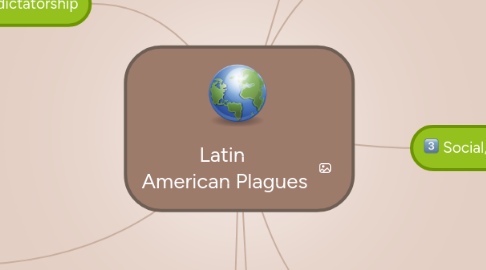
1. Filibusterismo and foreign intervention
1.1. Filibusteros
1.1.1. Pretend to take control of whole regions to create there independent states
1.1.2. Mexico
1.1.2.1. Affected by this in puerto de Veracruz by the french squad on 1838.
1.1.3. The north american intervention
1.1.3.1. Provoke the secession of Panama that belonged to Colombia until 1903
2. Golpismo, Militarism and dictatorship
2.1. Golpe de estado
2.1.1. Overthrow the government by force and non institutional medium.
2.2. Golpismo
2.2.1. Relays of government instead of ordered mechanisms
2.3. Long dictatorships
2.3.1. Mexico
2.3.1.1. Porfirio Díaz ( 1877-1911)
2.3.2. Chile
2.3.2.1. Agusto Pinochet (1973-1991)
2.3.3. Cuba
2.3.3.1. Fidel and Raul Castro since 1959
3. Internal Wars
3.1. Institutional fragility
3.1.1. Frequency of violence
3.1.1.1. To alter the existing order
3.1.2. Impose in a violent way their system
3.2. Mexico
3.2.1. Lost one million people (1910 - 1921)
3.3. Internal wars can be more wild and bloody than international wars
4. Caudillismo
4.1. Caudillos
4.1.1. Persons who lead their country not from the legal structure but from the attraction of their followers.
4.1.2. Disadvantages
4.1.2.1. Limits and weakens
4.1.2.1.1. The creation of fundamental institutions
4.1.2.2. Promotes dictatorship
4.1.3. Fragility of institutions have supported the emergence of caudillos
5. High levels of social and academic delay
5.1. Colonial societies highly stratified
5.2. Limited opportunities for progress of people
5.3. Even after the independence
5.3.1. Discrimination
5.3.2. Lack of opportunities
5.3.3. Bad education systems
6. Social, Ethnic and linguistic differencess
6.1. Societies divided because of the language and social classes
6.2. Racism that marginalizes indigenous
6.3. Lack of education
6.3.1. obstacle for the social mobility
7. Regional or Ideological Factionalism
7.1. Fraction
7.1.1. Group that is against other
7.1.1.1. One shows its unable to negotiate.
7.2. Those countries are consider as premoderns
7.3. • Gran Colombia
7.3.1. Divided
7.3.1.1. Venezuela
7.3.1.2. Colombia
7.3.1.3. Ecuador
8. Long Transitions to define institutions and internal structures
8.1. Countries with republic regime
8.1.1. Took generations in order to get a functional institutional framework.
8.2. Countries redacted many constitutions
8.2.1. Mexico
8.2.1.1. 400 changes since 1917

